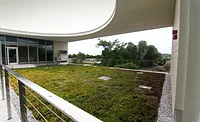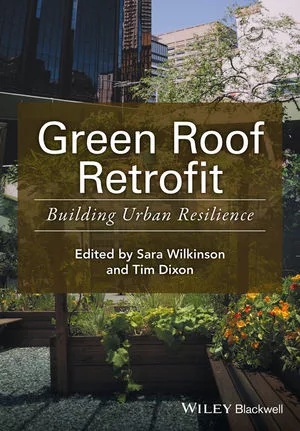Project Profile: Rooftop Patio Tops Off Green Roof at EPA Building
The original roof on Building 1 at the EPA's Atlantic Ecology Division was replaced with a greener option.

Just the Facts:
Location:
U.S. Environmental Protection Agency
Office of Research and Development
Atlantic Ecology Division
Wet Laboratory Building 1
Narragansett, Rhode Island
Architects:
Beatty, Harvey, Coco (BHC) Architects, LLP
New York
Contractor:
Custom Copper and Slate, Ltd.
Medfield, Mass.
Supplier:
ABC Supply Company, Inc.
Avon, Mass.
Products and Manufacturers:
• Mule-Hide TPO Roof System
Mule-Hide Products Company, Inc.
Beloit, Wis.
• GreenGrid Modular Green Roof System
Weston Solutions, Inc.
Vernon Hills, Ill.
• VAST Composite Deck Pavers
VAST Enterprises, LLC
Minneapolis
 Project Profile
Project Profile
The original 1963 roof at Building 1 at the EPA’s Atlantic Ecology Division in Rhode Island had a wood deck outside the director’s office. In 2009, the time had come for the roof to be replaced. “Consistent with the mission of the EPA, we specified a green roof,” said Mark Tagliabue, assistant facilities manager, Office of Research and Development, Atlantic Ecology Division, EPA. “The GreenGrid Modular Green Roof System was chosen for the project.”
The roof is 45 feet by 60 feet with a 12 foot by 24 foot deck area. “The plans included a new deck or patio as part of the green roof in order to provide access to the plantings and create a setting for showcasing the green building technology,” said Stefano Gagliano, BHC Architects, LLP, with offices in New York, Long Island and Baltimore.
The original specification was for a composite lumber deck. Custom Copper and Slate, headquartered in Medfield, Mass., was the project contractor. They were concerned that a composite lumber deck would put enough weight on its crossbeams to require a supporting substructure with posts anchored to the roof through the thermoplastic olefin (TPO) membrane that waterproofs the surface.
“With TPO, you want it to be seamless to ensure it’ll be waterproof. Penetrating the membrane to put in posts is something we try to avoid,” said Marc Green, an estimator with Custom Copper and Slate. “We were responsible for guaranteeing the roof. The last thing we want is to have to come back to fix leaks.”
Concrete pavers were a possibility. “We thought about concrete pavers,” said Gagliano. “But concrete pavers would have introduced their own weight problem.”
Green brought the problem to ABC Supply and Mule-Hide Products to get their suggestions. Mule-Hide recommended consideration of VAST Composite Pavers because they are lightweight and could be installed without putting posts through the membrane.
 Solution
Solution
VAST Composite Deck Pavers, which measure 3 inches by 6 inches with a 1.6-inch height, are a low-profile version of the company’s landscape pavers. They weigh 6.5 pounds per square foot, one-third the weight of similar size concrete pavers. Thus, they could be installed directly on the roof without harming the membrane.
The deck pavers are made from VAST’s engineered composite material that consists of a proprietary blend of up to 95 percent recycled car tires and plastic containers.
With its patented technology, VAST transforms post-consumer recycled rubber and plastics into composite masonry. VAST composite masonry products are cradle-to-cradle green. The manufacturing process starts with recycled materials, consumes 82 percent less energy and releases 89 percent less carbon dioxide than concrete product manufacture, generates no volatile organic compounds, yields zero scrap, and creates products that are 100 percent recyclable.
“My first impression of the VAST pavers was that it’s an ideal material for rooftop applications,” said Gagliano. “They are tough but lightweight, offer the timeless visual appeal of brick pavers, and we could match the paver color with the building’s exterior walls and the sedum to be planted in the GreenGrid system. That helped achieve a blending of the architectural elements of the roof.”
“VAST solved the weight problem,” said the EPA’s Tagliabue. “The recycled content makes it a green product and that was consistent with our goal of going green up on the roof.”
 Installation
Installation
VAST’s engineered paver solution features an installation grid system that makes it easier and faster for professional contractors to lay the pavers. When the pavers are inserted into the grid, they are correctly spaced and aligned. “We put the grid directly on top of the drain mat that went over the membrane,” said Green. “The material was great to work with: easy to carry, easy to cut, and easy on your hands. We found out that with VAST we can reduce installation time by half.”
“With the size of the pavers and give in the material, it could follow the contour of the roof and accept the roof’s slight rise. The installers got a nice, tight fit right up to the edges,” said Tagliabue. “The low profile of the pavers made the patio flush with the door from the director’s office so you can walk right out on the patio.”
“The best part of the project for me was when the director walked out the door and on to the patio for the first time,” said Green. “He had an ear-to-ear smile on his face that said all that needed to be said about the results of the installation.”

When the time came to replace the roof of Building 1 at the EPA’s Atlantic Ecology Division in Rhode Island, the EPA specified a green roof. (Photos courtesy of VAST Enterprises, LLC.)
Just the Facts:
Location:
U.S. Environmental Protection Agency
Office of Research and Development
Atlantic Ecology Division
Wet Laboratory Building 1
Narragansett, Rhode Island
Architects:
Beatty, Harvey, Coco (BHC) Architects, LLP
New York
Contractor:
Custom Copper and Slate, Ltd.
Medfield, Mass.
Supplier:
ABC Supply Company, Inc.
Avon, Mass.
Products and Manufacturers:
• Mule-Hide TPO Roof System
Mule-Hide Products Company, Inc.
Beloit, Wis.
• GreenGrid Modular Green Roof System
Weston Solutions, Inc.
Vernon Hills, Ill.
• VAST Composite Deck Pavers
VAST Enterprises, LLC
Minneapolis

Workers from Custom Copper and Slate install the composite deck pavers.
The original 1963 roof at Building 1 at the EPA’s Atlantic Ecology Division in Rhode Island had a wood deck outside the director’s office. In 2009, the time had come for the roof to be replaced. “Consistent with the mission of the EPA, we specified a green roof,” said Mark Tagliabue, assistant facilities manager, Office of Research and Development, Atlantic Ecology Division, EPA. “The GreenGrid Modular Green Roof System was chosen for the project.”
The roof is 45 feet by 60 feet with a 12 foot by 24 foot deck area. “The plans included a new deck or patio as part of the green roof in order to provide access to the plantings and create a setting for showcasing the green building technology,” said Stefano Gagliano, BHC Architects, LLP, with offices in New York, Long Island and Baltimore.
The original specification was for a composite lumber deck. Custom Copper and Slate, headquartered in Medfield, Mass., was the project contractor. They were concerned that a composite lumber deck would put enough weight on its crossbeams to require a supporting substructure with posts anchored to the roof through the thermoplastic olefin (TPO) membrane that waterproofs the surface.
“With TPO, you want it to be seamless to ensure it’ll be waterproof. Penetrating the membrane to put in posts is something we try to avoid,” said Marc Green, an estimator with Custom Copper and Slate. “We were responsible for guaranteeing the roof. The last thing we want is to have to come back to fix leaks.”
Concrete pavers were a possibility. “We thought about concrete pavers,” said Gagliano. “But concrete pavers would have introduced their own weight problem.”
Green brought the problem to ABC Supply and Mule-Hide Products to get their suggestions. Mule-Hide recommended consideration of VAST Composite Pavers because they are lightweight and could be installed without putting posts through the membrane.

The roof features a 12 foot by 24 foot deck area made of VAST Composite Pavers surrounded by a modular vegetative roof system from GreenGrid.
VAST Composite Deck Pavers, which measure 3 inches by 6 inches with a 1.6-inch height, are a low-profile version of the company’s landscape pavers. They weigh 6.5 pounds per square foot, one-third the weight of similar size concrete pavers. Thus, they could be installed directly on the roof without harming the membrane.
The deck pavers are made from VAST’s engineered composite material that consists of a proprietary blend of up to 95 percent recycled car tires and plastic containers.
With its patented technology, VAST transforms post-consumer recycled rubber and plastics into composite masonry. VAST composite masonry products are cradle-to-cradle green. The manufacturing process starts with recycled materials, consumes 82 percent less energy and releases 89 percent less carbon dioxide than concrete product manufacture, generates no volatile organic compounds, yields zero scrap, and creates products that are 100 percent recyclable.
“My first impression of the VAST pavers was that it’s an ideal material for rooftop applications,” said Gagliano. “They are tough but lightweight, offer the timeless visual appeal of brick pavers, and we could match the paver color with the building’s exterior walls and the sedum to be planted in the GreenGrid system. That helped achieve a blending of the architectural elements of the roof.”
“VAST solved the weight problem,” said the EPA’s Tagliabue. “The recycled content makes it a green product and that was consistent with our goal of going green up on the roof.”

The roof features a 12 foot by 24 foot deck area made of VAST Composite Pavers surrounded by a modular vegetative roof system from GreenGrid.
VAST’s engineered paver solution features an installation grid system that makes it easier and faster for professional contractors to lay the pavers. When the pavers are inserted into the grid, they are correctly spaced and aligned. “We put the grid directly on top of the drain mat that went over the membrane,” said Green. “The material was great to work with: easy to carry, easy to cut, and easy on your hands. We found out that with VAST we can reduce installation time by half.”
“With the size of the pavers and give in the material, it could follow the contour of the roof and accept the roof’s slight rise. The installers got a nice, tight fit right up to the edges,” said Tagliabue. “The low profile of the pavers made the patio flush with the door from the director’s office so you can walk right out on the patio.”
“The best part of the project for me was when the director walked out the door and on to the patio for the first time,” said Green. “He had an ear-to-ear smile on his face that said all that needed to be said about the results of the installation.”
Looking for a reprint of this article?
From high-res PDFs to custom plaques, order your copy today!






